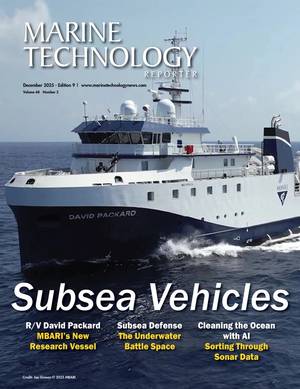
Marine Scientists Call for Rules on Marine Carbon Dioxide Sequestration
Unit at GEOMAR Helmholtz Centre for Ocean Research Kiel.“No marine carbon dioxide removal method currently has a sufficiently robust and comprehensive MRV system in place,” says Dr Helene Muri, a senior researcher at the Norwegian Institute for Air Research (NILU) and the Norwegian University of Science and Technology (NTNU), who co-led the working group together with Dr Olivier Sulpis from CEREGE – Aix-Marseille University, CNRS, IRD. “This means that efficient and safe implementation cannot be ensured at present.”The Brief highlights key research gaps. For example

AI is Boosting Operational Autonomy
floating glaciers of Antarctica. It was during one such mission that Ran was lost in January 2024.AI is helping AUV reliability - Ran II will have more robust decision support for emergencies and improved navigation.And it’s not just long-distance navigation that is being developed. Norwegian University of Science and Technology researchers recently published a study in Frontiers on a deep learning robotic-vision method that could help prevent unmanned underwater vehicles from disturbing nearby fish while operating in the confines of fish farms.A newly-published study published in Engineering

Nortek Nucleus Supports Coral Reef Photogrammetry Project
In a collaboration between the Norwegian University of Science and Technology (NTNU), University of Sydney, California Academy of Sciences (CalAcademy), Oceanly, University of Western Australia, and University of Auckland, supported by Inkfish, the University of Sydney’s Seeker AUV, equipped with a Nortek Nucleus 1000, worked alongside divers to create a 3D map of a coral reef off the coast of Tonga.Researchers from NTNU, the University of Sydney, and CalAcademy are working together to investigate how mesophotic reefs (low-light coral reefs in middle-depth waters) support the genetic diversity

CorPower Ocean, NTNU Join Forces for AI-Based Wave Energy Project
the adoption of artificial intelligence (AI) for improved performance and control in wave energy technology.The WACE project, short for Wave energy AI-based Control Enhancement, is now underway and is set to run until November 2025.CorPower Ocean is being supported by project partner Norwegian University of Science and Technology (NTNU).A model-based design framework will be used in the WACE project. After establishing requirements for the closed-loop control system, an AI-based optimal control strategy is being designed along with a hardware-in-the-loop (HIL) test setup.CorPower Ocean anticipates

Malaysian FPSO Giant Yinson Invests in Norwegian Autonomous Vessel Start-up
Zeabuz to realise waterborne mobility of the future. Our technology enables our customers to offer safer and more efficient operations while enabling entirely new mobility concepts such as urban waterborne mobility with reduced crew.”Zeabuz was founded in 2019 as a spin-off from the Norwegian University of Science and Technology's progressive research centre for autonomous marine operations and systems. The company has developed a proprietary autonomy platform that "is scalable, certifiable, and suitable for both new designs and retrofit of existing vessels."Their business model

Hearing the Light: DAS could Revolutionize Subsea Defense
During the summer of 2020, a group of Norwegian University of Science and Technology (NTNU) marine scientists based on the Svalbard archipelago successfully detected the vocalizations of baleen whales frolicking in Arctic Ocean and North Sea, some 70-90 kilometers away. At first blush this might seem somewhat unremarkable, given that researchers regularly monitor whale behavior, and whalesong has long been known to traverse great distances. But what made this particular set of observations special was the sensor of choice. It wasn’t a hydrophone, the trusted tool of the marine bioacoustics trade.

MTR100: Deep-sea Mining May Prove Pivotal in the Climate Change Discussion
in the mid-water column or closer to the seafloor, and how this may impact ecosystem processes and organism function.Dr. ir. Rudy Helmons, assistant professor for offshore and dredging engineering at Delft University of Technology, and adjunct associate professor for deep-sea mining at Norwegian University of Science and Technology, is experimenting with the nodule collection process, as well. In a previous EU H2020 project, Blue Nodules, the collection technology was proven as effective, with a hydraulic or mechanical nodule collector skimming the seafloor, separating nodule from sediment, and dischargin

Wilhelmsen, NorSea Acquire Stake in Norwegian Deep-sea Mining Firm
said.Norway Eyes Sea Change in Deep Dive for Metals Instead of Oil"Rich with in-demand metals, such as copper, zinc, cobalt, scandium, and additional rare earth elements, the minerals on the Norwegian Continental Shelf (NCS) alone are estimated, by an independent study conducted by the Norwegian University of Science and Technology, to be worth a total of USD 100 billion and could support the creation of 20000 new jobs," the press statement by the duo reads.NorSea Group and Wilhelmsen will be represented on the Loke Marine Minerals’ board by Wilhelmsen’s Espen Gjerde, VP Strategy

Environmental Groups Call on Norway to Stop Deep-sea Mining Plans
organization Naturvernforbund (Friends of the Earth Norway) said."Mining on the seabed can destroy species and habitats that have an important role for both the sea and the planet."Steinar Loeve Ellefmo, an associate professor who heads a study program on deep-sea mining at the Norwegian University of Science and Technology, said the study wasn't premature."I do not think it can be too early to collect data to learn," he said. (Reporting by Nerijus Adomaitis; editing by David Evans)Norway Eyes Sea Change in Deep Dive for Metals Instead of OilNorwegian Seismic Company Dives
 December 2025
December 2025





